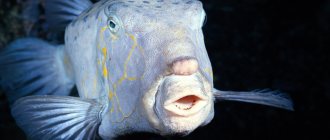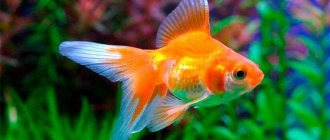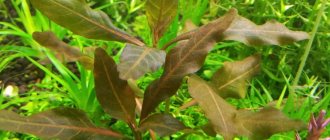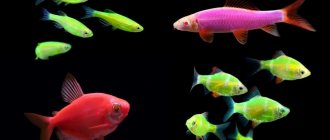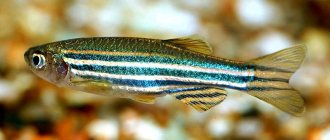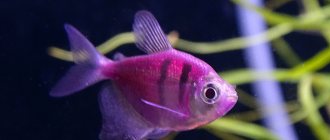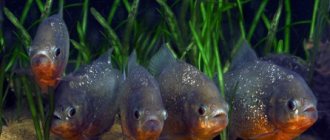Most beginners in aquarium farming begin by breeding viviparous fish - unpretentious, active, easy to care for and maintain. And Velifera molly, also known as sailfish or sailfish, although with some reservations, belongs to this category. Such a peaceful inhabitant will not create any special problems and will delight you with its spectacular appearance, because it is not for nothing that Velifera is considered the most beautiful representative of the Gambusia family. What kind of fish is this, and how to properly care for it?
History and description
There is more than one species of mollies, and Sphenops mollies were the first to be studied and described. Back in 1846, zoologist Achille Valenciennes included data about them in his 22-volume work “Natural History of Fishes”. As for Velifera, it was first discovered in a small freshwater lake on the Yucatan Peninsula. At the end of the 19th century, the famous ichthyologist-systematist Charles Tate Regan studied samples from the British Museum of Natural History and described two types of mollies - free and sailing, that is, velifera.
Sailfish were originally an endemic species found exclusively in the Yucatan Peninsula. However, over time, their natural habitat expanded, and today it extends from Mexico to Colombia. Velifera is inhabited by numerous streams that flow into the Caribbean Sea, including estuaries where the water is quite brackish.
The sailfin molly has also successfully adapted to the waters of the Middle East, Southeast Asia, Australia and New Zealand. But this could not have happened without humans; experts believe that these fish got into nature, having originally been aquarium inhabitants, and turned into an invasive species.
In its natural habitat, brackish, freshwater and marine reservoirs are suitable for velifera. Surprisingly, in bodies of water with high salinity, the largest and most brightly colored specimens are found, which are much more spectacular than their freshwater counterparts.
The sail molly came to European countries at the beginning of the 20th century, where it was classified as a member of the genus Poeciliidae. Velifera is the largest representative of the family. In the wild, individuals grow up to 200 mm in length, but aquarium “sailfish” are inferior in size. As a rule, the length of females does not exceed 140 mm, males - 10-12 mm.
Nature did not skimp and generously rewarded the velifera with an amazing natural color: the body of the fish is covered with grayish-silver scales, decorated with an abundance of iridescent small spots. The chest of the fish has a luxurious, yellowish-golden tint.
The dorsal fin answers the question of why the fish was nicknamed “sailfish”, “high fin” or “sailfish”. Its size is almost equal to the length of the entire body of the velifera; there is a bright red edging along the edge of the fin. But only males have such a spectacular “accessory”. Females have a more modest dorsal fin, but they have another advantage - the size of the body is slightly larger.
The body of the sailing molly is elongated and high. Naturally shaped fish have tail fin . If the velifera has a lyre-shaped tail, then this could not have happened without selection intervention. The tips of the lyre-shaped fins are often so elongated that they come into contact. But, as many aquarists admit, fish with a rounded tail have a more harmonious, natural appearance.
In addition, lovers of live-bearing fish often choose “round-tailed” individuals, having their own motives for this. Thus, it is believed that they quickly turn into adult fish capable of producing offspring, and at the same time reach larger sizes than artificially bred varieties.
General information about the fish
Black mollies or in English - black Molly, is a breeding form of mollies. It is not known for certain from which natural species this breed originated. There is an opinion that the ancestor of molly is Molliesia sphenops; according to another hypothesis, it is Molliesia latipin.
The fish belongs to the genus Pecilia (according to modern classification). But out of habit, aquarists call it mollies. For ordinary aquarists, it does not matter much which fish the black Molly came from, since this does not in the least affect the conditions of maintenance and care - they are the same for all mollies.
Black mollies, although not found in nature, are distinguished by unprecedented endurance and ease of reproduction. This viviparous fish is unpretentious and undemanding, so it is recommended for beginner aquarists.
Velifera mollies color variations
There are only three stable color forms of sailing mollies that do not have any impurities: natural, marbled and albino. The latter forms are the product of selection, but representatives of other “species relatives” did not participate in the work.
Albino velifera are yellowish-orange in color, with scales bluish-white. Another distinctive feature of albinos is red eyes. A painstaking intraspecific selection of albino swallowtails was carried out, resulting in the appearance of individuals with varying colors - from light yellow to bright red, almost red shades.
Marble velifers, which can also be found by their commercial name - “snowflakes”, have a dazzling snow-white “outfit”. Dark eyes and magnificent fins look impressive against the background of white scales. The dorsal and caudal fin have an amazing, bright blue tint. When they are straightened, they look like the finest handmade lace.
In order for the “marble” sailfish to “play” and shimmer effectively, the aquarist should provide the tank with high-quality overhead lighting. Under good light, they will look like pieces of white marble or snow sparkling under the sun's rays. Marbled mollies were created through a selection process within the species. Experts methodically selected wild individuals with the lightest color, and then crossed them.
Conditions of detention
If we evaluate the needs of the sailing molly as a whole, it turns out that it is a very unpretentious and non-capricious aquarium inhabitant. However, a fish from warm regions and its familiar environment are somewhat different from standard aquarium conditions, which is worth taking into account so that the inhabitant feels good, does not get sick and lives a long life. It is advisable to pay special attention to the following aspects.
Lighting
Velifera is very light-loving, so you will need to provide the container with additional artificial lighting. At the same time, natural light should enter the aquarium for at least 2-3 hours a day.
Availability of cover
These fish are hyperactive and playful; they often end up outside their native aquatic environment, jumping out of the aquarium during play or spotting “prey.” To prevent such tragic accidents, experienced aquarists advise equipping the tank with a reliable lid.
Aquarium vegetation
Like other poeciliaceae, velifera are good and careful with plants. And if the inhabitants suddenly began to feast on young shoots, then, most likely, they do not have enough plant food on their menu. In the aquarium of “sailboats” there must be thickets of floating plants, which serve not only as decoration, but also as shelter for newborn offspring.
The rest of the plants are planted along the edges so that the center of the tank remains free for swimming by agile and active inhabitants. Vallisneria, cryptocoryne, and Japanese arrowhead are suitable for this. Often these plants are covered with filamentous algae, which mollies love to feast on.
Aquarium size
This factor should be given special attention, since the size of the tank will determine how beautiful and stately the males will grow, and how tall and luxurious their dorsal fins will be. Calculate the area so that there is at least a liter of water per 10 mm of the fish’s body.
Water purity and oxygen saturation
Sail mollies are quite sensitive to the quality of the aquatic environment and the presence of organic matter in it. It is recommended to change the water weekly by a quarter of the total volume and be sure to equip the aquarium with an aeration device, since these inhabitants often die due to oxygen deficiency. Also, sailboats feel better in hard water, which means this indicator should be monitored.
Is it necessary to add salt to the water in the aquarium if it contains velifers? Some owners do add a little salt. But in general, this issue is resolved individually. So, if the fish lived in fresh water, then there is no need to enrich the aquatic environment with salt, and a salty environment will not benefit plants and other inhabitants.
Instead, it is recommended to carry out “molly” periodic procedures - short-term maintenance in salt baths. The event lasts 10-15 minutes, the strength of the solution is 3-4%. In addition, salt bathing is an excellent prevention of various diseases. For sea sailboats, if there are no neighbors, you can add salt to the water - 2 g of table or sea salt per 1 liter.
As for the recommended water parameters, the following indicators are considered the most comfortable for velifer:
- optimal temperature – +24 – +26°С, deviation of 2 degrees in one direction or another is allowed;
- hardness – 15-35°dH;
- pH value – 0-8.5 pH.
It is recommended to use small pebbles as soil.
Compatibility
Peacefulness is another positive characteristic of mollies. It makes them convenient for keeping in community aquariums. At the same time, in order to avoid conflicts within the mollies flock itself, it should be dominated by females at the rate of 3-4 females per male. When choosing neighbors, it is recommended to give preference to fish that are similar in size. The fish get along well with zebrafish, catfish, and ancistrus.
All species, except Velifera, are able to get along with barbs. To keep them in a community aquarium, take care to arrange shelters made of driftwood and grottoes. Neighborhood with aggressive species, such as cichlids, is not recommended.
mollies compatibility table
Who do sailing mollies get along with?
These fish, like the rest of the platies, are very peaceful inhabitants, so they get along well with harmless aquarium inhabitants. They are calm, non-conflict and non-bullying. Another thing is that sailfish prefer water with high levels of hardness and pH, which limits the range of possible neighbors.
Sail molly fish are schooling fish; they feel comfortable in a group of their own kind and are accustomed to observing hierarchical canons. Stable pairs are not formed among them. The top level of the hierarchy is occupied by large males. But, although they “monitor” order in the group, they do not show aggression towards the other members of the pack and, moreover, do not cause them serious injuries.
It is recommended to keep a flock with an equal number of males and females.
She is outwardly more attractive than a family with a larger number of females. Also in this case, a natural situation is created where males can compete, which is what happens in the natural environment.
When the males begin courtship, their fins fully open, making the fish incredibly attractive. They impetuously circle around the “bride,” and she floats away to the side with an imperturbable look, as if this amazingly beautiful sight does not bother her at all.
Excellent company for sailfin mollies are other platies that prefer hard water. You can add swordtails, platies, guppies and mollies of other varieties to them. Velifera has good compatibility with characins: tetras, neons, thorns. But it is worth taking into account that a soft water environment is more suitable for characins, in which sailfish can get sick.
The following representatives of the aquarium world get along well with Velifera mollies:
- small fish from the carp family: zebrafish, cherry barbs, rasboras;
- rainbowfish, which also like hard water;
- labyrinthine: gourami and lalius;
- peaceful cichlids: angelfish, apistogramma.
You should not choose “dirty” fish as neighbors for sailboats that rip off the neighbors’ luxurious fins. Sumatran barbs belong to this category. American and African cichlids can be considered dangerous for velifera. They are too cocky and territorial, which is why the molly will not be able to fight back.
Peculiarities of reproduction of sailing mollies
The fish are viviparous, so the maturation of eggs occurs inside the female, and already viable fry are born. About 40-50 days pass from the moment of fertilization to the birth of almost a hundred 6-8 mm babies.
You can feed newborn offspring with starter food - Artemia and Cyclops nauplii, newborn daphnia. Gradually you should move to larger and more nutritious rations. If microfeeds are not available, then crushed tubifex and bloodworms are used. The particle size should not be more than 0.1-0.2 mm, this is the approximate diameter of the fry's eye.
In the first 4-5 weeks, the offspring need to be fed 4-6 times a day. Babies grow unevenly, large individuals can be immediately noticed in the general mass. Already initially, culling should be carried out, removing young animals that have any developmental defects.
Fish respond well to quality care; as a rule, within six months you can get strong, well-developed individuals that can grow in 18-24 months in unfavorable conditions. With high-quality maintenance, velifers reach puberty faster and have a longer period of reproductive activity.
Sailing mollies, kept in ideal conditions, become adults by 6-8 months, which is quite late by livebearer standards. But their life span is longer; some specimens live 4.5-5 years or longer.
While many viviparous fish are guilty of “cannibalism” and are not averse to feasting on their own fry, molly fish are not one of them and do not have such a “habit”. But in order to create the most comfortable conditions for the young and establish a suitable feeding regime, experienced aquarists still advise placing the fry in a separate tank filled with water from the aquarium. Its parameters should correspond to the standard ones, except that it should be heated a couple of degrees and maintained at this level in the first couple of weeks.
Raising fry is not difficult; it is enough to pay attention to standard procedures:
- feed the offspring well and regularly;
- change water weekly;
- provide round-the-clock filtration;
- remove dirt from the bottom with a siphon (read more about how to properly siphon soil in an aquarium);
- wash the filter material.
The container in which the offspring are raised must be spacious. In a cramped tank, fry develop more slowly, and as a result, many “dragged” individuals grow up. It is important to constantly monitor the state of the aquatic environment, since sailfish are highly sensitive to calcium deficiency, which enters the body from water.
Reviews
Peter T., a beginner aquarist. Black lyretail mollies are the most beautiful and unpretentious fish. To make them as comfortable as possible, I bought a large, 50-liter aquarium for three fish. They constantly move from wall to wall, hide in the grass and grottoes, and are very mobile and active during the day.
Rustam P., experienced aquarist. During my acquaintance with black molly, I recorded several cases of unexpected aggression - the gloomy fish are not as good-natured as they are said to be. But in general, mollies are easy-going, peaceful, and will eat anything—ideal for beginners.
It is not for nothing that the black molly is considered one of the most popular aquarium fish. Aquarists are attracted to the coal-black mollies by the combination of their unusual exterior with unpretentiousness and ease of reproduction.
How and what to feed Velifera molly
The diet of these aquarium inhabitants should be complete and varied. More monotonous food is suitable for juveniles, but adults need a richer menu. Velifers happily eat almost any live food, mainly consisting of bloodworms, coretra, and tubifex. The latter should first be kept in water for 2 weeks, replacing it often, and before serving to the fish, rinse thoroughly under running water.
If possible, it is recommended to alternate between regular bloodworms and estuary bloodworms. In their natural environment, such bloodworms inhabit the brackish water of estuaries; they are rich in mineral components and are most useful for sailfish.
The diet of these aquarium inhabitants must include plant foods. They can be given Wolffia, semolina, and rolled oats. The last product is pre-scalded with boiling water. By the way, rolled oats and semolina make the water cloudy, which spoils the appearance of the aquarium. Such food is usually given to the inhabitants of a nursery aquarium, where there is no soil, and the remains are easily removed from the bottom.
It is better for residents of a decorative aquarium to be given ready-made food that does not spoil the water. Aquarists often treat their lifefish with chopped greens and spilled with boiling water. But, despite the benefits of such food for fish, they “taste” it and spit it out, giving preference to more tasty and attractive food.
It is important to take into account that sailing mollies are quite picky when it comes to food, and if they are not immediately taught to eat plant fiber and cereals, then later they will refuse such dishes. As they grow older, velifers completely lose interest in plant food.
One adult fish requires approximately 3% of its own weight in food per day. The daily regimen consists of 3 feedings for young fish and 1-2 feedings for adult fish.
The daily diet of growing young animals includes a mixture of daphnia (live) and cyclops, oatmeal flakes and bloodworms. The interval between two feedings is about 5.5-6 hours. In the next day, you can give your pets steamed semolina and finely ground brine shrimp soaked in boiling water.
The owner of the aquarium can, at his discretion, combine food of plant and animal origin. The main thing is that all food is of high quality, and the dishes are varied. Adult fish will benefit from fasting days, when they are not fed once or twice a week. But it is not recommended for juveniles to go on such short-term hunger strikes.
It is important not only to correctly plan the diet and adhere to the feeding regimen, but also to determine the portion size as accurately as possible. Balance is necessary, since both overfeeding and underfeeding will cause serious health problems for aquarium inhabitants.
Benefits of Daphnia
Valuable components of the mollies menu are food, which includes animal components of plankton - daphnia and cyclops:
- They contain a whole range of components useful for the “fish” body.
- Daphnia caught in the spring from reservoirs whose water is actively “blooming” are especially valued. Such crustaceans are compared to “sandwiches” consisting of animal and plant products.
- Microelements contained in the body of daphnia are necessary for fish to produce pigment, which provides their unusual coloring.
- Crustacean chitin, which is particularly hard, is considered a valuable ballast material - it helps remove toxins from the body of the velifer, this also applies to salts of heavy metals.
If you regularly feed sailing mollies with daphnia, their life cycle will be longer and their reproductive activity will be stabilized. In addition, this food has a beneficial effect on the immune system of fish, and they are more resistant to various diseases and parasites.
Nutritional supplements
When feeding the “sailfish” with bloodworms, coretra and especially tubifex, it is recommended to enrich the food with multivitamins. Typically, aquarists purchase food in the form of pills or granules, grind them to a powder and sprinkle them on each serving of wet food. Before serving, such food should sit for 50-60 minutes at room temperature. Then the food should be rinsed under running cool water and poured into a container.
Live food contains little vitamins D and E, for this reason experts advise enriching food with them, adding 1 drop of fat solutions of these vitamin substances for every 10 g of product. Often, artificial diets from domestic producers are poor in vitamins A, D and E. They are supplemented with the natural preparation trivitamin, at the rate of 1 drop per amount of dry food that fits in a matchbox.
If you create a varied and balanced diet, you can not only grow healthy, beautiful fish, but also start breeding velifera and even start breeding work.
Velifer diseases and treatment features
When fish live in a favorable environment, peaceful coexistence with neighbors and a balanced diet, the risks of developing any diseases are minimal.
Sailing mollies are very sensitive to changes in the hydrochemical composition of water; a decrease in pH and dGH has a depressing effect on the organs and systems of fish. In such conditions, they may develop fungal or bacterial infections.
The problem can be solved by normalizing and stabilizing the indicators of the aquatic environment. As the disease progresses, treatment with medication is usually required. But it is necessary to take into account some features:
- mollies are difficult to tolerate products containing copper;
- You need to focus on the dosages specified in the instructions; exceeding them can lead to the death of aquarium inhabitants;
- the use of organic dyes - methylene blue, malachite green oxalate, as well as antibiotics for the treatment of velifera, is acceptable, but with obligatory adherence to the dose;
- When using white streptocide tablets, it is recommended to be extremely careful - if the fish mistakes the particles for food and swallows them, it will initially lose color and then die.
A dangerous situation is when a finely dispersed water-air mixture is supplied to the tank through a compressor diffuser. Mollies can develop gas embolism, in which air bubbles from the water enter the circulatory system and cause the death of the fish. To prevent this, the air supply must be adjusted and the aquarium equipment must be in good working order.
The immunity of sailfish is quite strong from birth, and they have high resistance to many diseases. Therefore, when living in a well-equipped container with healthy neighbors, velifers do not get sick.
But there is always the possibility that pathogenic microorganisms will enter the aquatic environment from the outside, for example, with live food, plants or new inhabitants.
Therefore, you should not give fish questionable food or plant vegetation if there are even minor signs of damage. It is recommended to keep all “new arrivals” in a quarantine container to avoid possible difficulties.
Velifera molly is not the easiest fish to care for and maintain when compared, for example, with guppies and swordtails. However, she has important advantages - incredible external beauty and an easy-going character. If you follow the basic rules, then a novice aquarist has a chance to become the happy owner of a beautiful Velifera.
Nutrition
Omnivorous species. In a home aquarium, it will accept most popular foods. A good choice would be products tailored to the needs of Mollies, produced by many manufacturers. Such foods already contain a large amount of herbal additives - an essential component in the daily diet. If it is deficient, fish can severely damage delicate aquarium plants.
Our product Aqvium natural dry food for small and medium fish from clean lakes of Siberia and Northern Crimea in environmentally friendly biodegradable packaging.
Find out more

